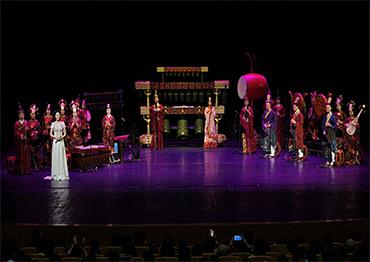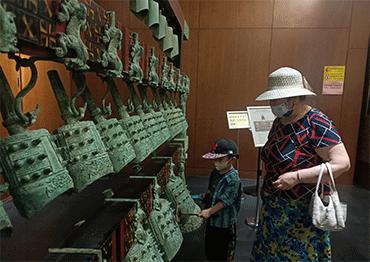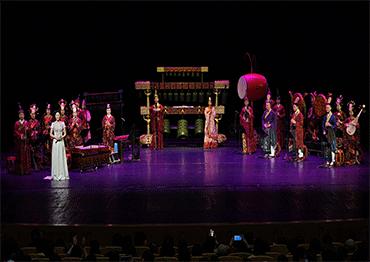A set of bronze chimes from more than 2,400 years ago reveals new aspects of ancient Chinese music, unexpectedly retuning our understanding of global music history

The orchestra of the Opera and Dance Drama Theater of Hubei Province performs during the second Chime Festival held in Wuhan, Hubei Province, April 17, 2024 (Photo by VCG)
With the exception of the Egyptian pyramids, the seven wonders of the ancient world have been lost to history. Yet there are still historical sites in the world that can stake a claim to being the eighth wonder, including the Taj Mahal in India, the Great Wall of China, the Terracotta Warriors left behind by China’s first emperor Qin Shi Huang, or the Zenghouyi Chimes, also known as the Bianzhong of Marquis Yi of Zeng.
The chimes are an enormous musical instrument dating from China’s Warring States Period (475-221 BCE), excavated in 1978 in Suixian County, Central China’s Hubei Province.
This set of chimes is particularly large. Its frame, an L-shaped copper and wood structure, is 7.48 meters long and 2.65 meters high with 65 bells suspended from it. The frame has three tiers with higher tones on top and lower tones at the bottom. Nineteen bells are clustered into three groups on the highest tier, while 33 mid-range bells hang across the middle, with 12 larger bells at the bottom.
The largest bell is 1.52 meters tall and weighs a whopping 203.6 kilograms. Collectively, the bells weigh 2.5 metric tons, and the whole set, frame and all, totals nearly five metric tons.
The frame and the bronze bells are covered with carvings, etchings, paintings and other ornaments. The inscriptions consist of 3,755 Chinese characters that record historical events, music theory and the sounds that each bell produces.
But the most amazing thing is that such a huge set of chimes was found intact, with the bells still hanging in place on the frame. Even the painted mallets and sticks used for playing the massive instrument were found alongside the bells.

A child plays replica chimes, Chinese Archaeological Museum, Beijing, June 6, 2024 (Photo by Du Guodong)

A man takes a photo of a Zenghouyi Chimes sculpture on a subway station wall in Wuhan, Hubei Province, December 31, 2023 (Photo by VCG)
Accidental Discovery
In September 1977, as People’s Liberation Army troops were building a factory in Suixian County, a large tomb dating back to the early Warring States period was discovered. It was named the Zenghouyi Tomb. About a year later, Hubei Provincial Museum sent an archaeological team to establish the tomb’s origin. To their amazement, they found that it was several times larger than the famed Mawangdui Han Tomb in Changsha, Hunan Province, which dates from the Western Han Dynasty (206 BCE-9 CE), and seven or eight times larger than Tomb No.1 in Wangshan, Hubei Province where the 2,000-year-old Sword of Goujian was found.
The combined area of the inner and outer chambers of Zenghouyi Tomb occupied a space of more than 190 square meters, the largest tomb discovered in China at the time.
Their excitement was punctured somewhat by the discovery of what the team called a “robbery hole” – evidence that the tomb had already been looted by raiders. Feeling disheartened and with greatly lowered expectations, the team continued digging. After removing silt, they saw broken slabs, further evidence that the tomb had been visited by grave robbers. Moreover, there was a large amount of muddy water in the burial chamber, which meant the tomb had been flooded at some point.
The archaeological team reported to their superiors that the tomb had been severely damaged and requested a quick rescue excavation. This began almost immediately, and once the soil layer was completely removed, nearly 50 giant stone slabs were exposed.
After opening the outer chamber, archaeologists found many wooden coffins floating in the muddy water. In order not to damage the burial items after draining the water, the team used a crane to lift the coffins out. Inside the coffins, they found the remains of 23 teenage girls. At that time, people thought these girls must have been sacrificed to serve their master, but after the whole set of chimes was unearthed, it was concluded that the young ladies were musicians. They were entombed by their master, along with the set of chimes, so they could continue to play music in the afterlife.
Shortly afterward, the largest coffin in the chamber was excavated, and the inscription on a buried bronze goblet indicated that the tomb belonged to Marquis Yi of the Zeng state.
With further excavation, the top layer of the chimes was revealed, but at that point, there was still more than two meters of water. When the water was eventually drained, the team’s level of excitement reached a new peak. The chimes had been immersed in water for thousands of years, and it is because of this that the chimes and the complete wooden frame had been preserved so well. It is also what probably deterred the tomb raiders, leaving a huge treasure trove of cultural relics for future generations to enjoy.
In another chamber, 13 wooden coffins were found, as well as a large number of wooden carriages and the skeletons of horses. From the four chambers, more than 15,000 artifacts were excavated including ritual items, musical instruments, carriages, horses, gold, silver and weapons. Many have peculiar shapes and are adorned with gorgeous decorations, reflecting the differences between Chu culture and Zhongyuan culture. During the Spring and Autumn Period (770-476 BCE), and the Warring States period, Chu was the largest state in terms of area within the territory of Hubei, with its capital at Jiangling for 400 years. Zhongyuan culture refers to the culture that was prevalent in much of Henan Province, to the north of Hubei, which has long been regarded as the cradle of Chinese civilization.
Chimes are a fairly common instrument in ancient China, and evidence of them has been around since the Bronze Age Shang Dynasty (1600-1046 BCE), the earliest ruling dynasty to be established in China’s recorded history. To this day, more than 40 sets of chimes have been excavated across the country, but the Zenghouyi Chimes are by far the largest, heaviest, best-preserved and finest set of chimes ever unearthed in China.
King of the Ring
One characteristic that sets these chimes apart from others is that it can play not only the five-tone scale, but also the six-tone scale and even the seventone scale. Their unique oval design means that each bell can produce two different tones depending on where it is struck. This was a groundbreaking discovery for the study of ancient Chinese music because before the appearance of this instrument, people thought that Greece was where the seven-tone scale first appeared.
In addition to the 64 suspended bells, there is one bell with a flat bottom called Bo, which was not originally one of the chimes in the set. The inscriptions on the Bo chime reveal that it was a funeral gift from King Hui of the Chu State for Marquis Yi of Zeng. But why did the Chu superpower send a posthumous gift to the marquis of such a smaller state?
According to Records of the Historian by Sima Qian, the first Chinese book on general history ever written in a biographical style in 91 BCE, in the 10th year in the reign of King Zhao of Chu, the king of the Wu State pursued and tried to kill King Zhao, who desperately fled to the Sui state. Wu soldiers asked the Sui government to hand over Zhao, but the request was flatly refused. The king of Wu had no choice but to retreat with his troops.
After that, the powerful Chu maintained good relations with the relatively weaker Sui. According to recent research, the state of Sui, located in today’s Suizhou in Hubei Province, matches the Zeng state exactly.
Decades later, King Hui of Chu received news of the death of the Marquis Yi of Zeng and sent a special bell as a sign of condolence. That bell was placed in the middle of the set of chimes to show respect for Chu.
Although the state of Zeng was small, it was well-known for its rich musical and ritual culture. Among the more than 15,000 cultural relics that have been unearthed dating to that time, 125 are different musical instruments, including stone chimes, ancient Chinese plucked zithers, traditional reed instruments and drums, which when combined resemble the makings of an orchestra. Many are still unique archaeological findings, providing a rich and direct historical reference for future generations to study ancient Chinese music.
Bronze Tones
The Zenghouyi Chimes have been played three times since the set was unearthed. The first time was in Wuhan, capital city of Hubei Province, the year it was discovered. It was used to play the popular Chinese revolutionary song “The East Is Red,” for which a documentary was filmed.
The second was at the National Museum of China in Beijing in 1979 to commemorate the 30th anniversary of the founding of the People’s Republic of China, the only time the chimes have left Hubei Provincial Museum. The third was recorded in 1997, which was then edited into a performance of symphonic music to mark the return of Hong Kong to China.
The Zenghouyi Chimes are a genuine miracle in the history of ancient Chinese music, not only because they inform us about the rituals and music of ancient China, but also because they demonstrate the highest level of bronze casting techniques. As a result, the Zenghouyi Chimes were listed among the first 64 national treasures that will never be exhibited outside of China.
In 1987, under the auspices of the National Cultural Heritage Administration, a complete replica of the instrument was made, and the Hubei Provincial Museum set up a team to play it, which later became the Hubei Provincial Museum Chime Bell Orchestra.
According to an interview with China Plus, Jay Xu, curator of San Francisco’s Asian Art Museum, believes the chime set was the most sophisticated musical instrument ever produced at the time.
“It was absolutely the most sophisticated musical instrument in the entire world, not only in China. The discovery of the Zenghouyi Chimes is not one of the most important archaeological discoveries in China so far, it is the most important one,” Xu said.
Such an important part of music history was meant to be heard rather than only preserved. In an effort to provide both preservation as well as access, the Hubei Provincial Museum Chime Bell Orchestra collected 613 digital samplings from the Zenghouyi Chimes in March 2023. Each of the 65 bells was struck from the front and from the sides using varying levels of intensity. Now, the sounds of the bells are available through a WeChat mini-app that allows musicians to compose their own music simply by tapping a button.

 Old Version
Old Version


